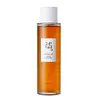What's inside
What's inside
 Key Ingredients
Key Ingredients

 Benefits
Benefits

 Concerns
Concerns

No concerns
 Ingredients Side-by-side
Ingredients Side-by-side

Panax Ginseng Root Water
MaskingButylene Glycol
HumectantGlycerin
HumectantPropanediol
SolventNiacinamide
Smoothing1,2-Hexanediol
Skin ConditioningWater
Skin ConditioningHydroxyacetophenone
AntioxidantGlyceryl Glucoside
HumectantXanthan Gum
EmulsifyingPanthenol
Skin ConditioningDipotassium Glycyrrhizate
HumectantAllantoin
Skin ConditioningAdenosine
Skin ConditioningPanax Ginseng Callus Culture Extract
Skin ConditioningTheobroma Cacao Extract
Skin ConditioningDextrin
AbsorbentGlucose
HumectantPanax Ginseng Root Extract
EmollientPanax Ginseng Berry Extract
Skin ConditioningLactobacillus
Skin ConditioningSodium Hyaluronate
HumectantEthylhexylglycerin
Skin ConditioningDisodium EDTA
Panax Ginseng Root Water, Butylene Glycol, Glycerin, Propanediol, Niacinamide, 1,2-Hexanediol, Water, Hydroxyacetophenone, Glyceryl Glucoside, Xanthan Gum, Panthenol, Dipotassium Glycyrrhizate, Allantoin, Adenosine, Panax Ginseng Callus Culture Extract, Theobroma Cacao Extract, Dextrin, Glucose, Panax Ginseng Root Extract, Panax Ginseng Berry Extract, Lactobacillus, Sodium Hyaluronate, Ethylhexylglycerin, Disodium EDTA
Water
Skin ConditioningAlcohol Denat.
AntimicrobialHamamelis Virginiana Water
AstringentGlycereth-26
HumectantNiacinamide
SmoothingCoceth-7
EmulsifyingTrideceth-9
EmulsifyingPPG-1-PEG-9 Lauryl Glycol Ether
EmulsifyingPEG-5 Ethylhexanoate
EmulsifyingSorbitol
HumectantCamellia Sinensis Leaf Extract
AntimicrobialPanthenol
Skin ConditioningSodium Citrate
BufferingPEG-40 Hydrogenated Castor Oil
EmulsifyingPhenoxyethanol
PreservativeLavandula Angustifolia Oil
MaskingDisodium EDTA
Salicylic Acid
MaskingOrmenis Multicaulis Oil
MaskingRosmarinus Officinalis Leaf Oil
MaskingSalvia Officinalis Oil
MaskingBenzoic Acid
MaskingCitric Acid
BufferingLinalool
PerfumingLimonene
PerfumingWater, Alcohol Denat., Hamamelis Virginiana Water, Glycereth-26, Niacinamide, Coceth-7, Trideceth-9, PPG-1-PEG-9 Lauryl Glycol Ether, PEG-5 Ethylhexanoate, Sorbitol, Camellia Sinensis Leaf Extract, Panthenol, Sodium Citrate, PEG-40 Hydrogenated Castor Oil, Phenoxyethanol, Lavandula Angustifolia Oil, Disodium EDTA, Salicylic Acid, Ormenis Multicaulis Oil, Rosmarinus Officinalis Leaf Oil, Salvia Officinalis Oil, Benzoic Acid, Citric Acid, Linalool, Limonene
 Reviews
Reviews

Ingredients Explained
These ingredients are found in both products.
Ingredients higher up in an ingredient list are typically present in a larger amount.
Disodium EDTA plays a role in making products more stable by aiding other preservatives.
It is a chelating agent, meaning it neutralizes metal ions that may be found in a product.
Disodium EDTA is a salt of edetic acid and is found to be safe in cosmetic ingredients.
Learn more about Disodium EDTANiacinamide is a multitasking form of vitamin B3 that strengthens the skin barrier, reduces pores and dark spots, regulates oil, and improves signs of aging.
And the best part? It's gentle and well-tolerated by most skin types, including sensitive and reactive skin.
You might have heard of "niacin flush", or the reddening of skin that causes itchiness. Niacinamide has not been found to cause this.
In very rare cases, some individuals may not be able to tolerate niacinamide at all or experience an allergic reaction to it.
If you are experiencing flaking, irritation, and dryness with this ingredient, be sure to double check all your products as this ingredient can be found in all categories of skincare.
When incorporating niacinamide into your routine, look out for concentration amounts. Typically, 5% niacinamide provides benefits such as fading dark spots. However, if you have sensitive skin, it is better to begin with a smaller concentration.
When you apply niacinamide to your skin, your body converts it into nicotinamide adenine dinucleotide (NAD). NAD is an essential coenzyme that is already found in your cells as "fuel" and powers countless biological processes.
In your skin, NAD helps repair cell damage, produce new healthy cells, support collagen production, strengthen the skin barrier, and fight environmental stressors (like UV and pollution).
Our natural NAD levels start to decline with age, leading to slower skin repair, visible aging, and a weaker skin barrier. By providing your skin niacinamide, you're recharging your skin's NAD levels. This leads to stronger, healthier, and younger looking skin.
Another name for vitamin B3 is nicotinamide. This vitamin is water-soluble and our bodies don't store it. We obtain Vitamin B3 from either food or skincare. Meat, fish, wheat, yeast, and leafy greens contain vitamin B3.
The type of niacinamide used in skincare is synthetically created.
Learn more about NiacinamidePanthenol is a common ingredient that helps hydrate and soothe the skin. It is found naturally in our skin and hair.
There are two forms of panthenol: D and L.
D-panthenol is also known as dexpanthenol. Most cosmetics use dexpanthenol or a mixture of D and L-panthenol.
Panthenol is famous due to its ability to go deeper into the skin's layers. Using this ingredient has numerous pros (and no cons):
Like hyaluronic acid, panthenol is a humectant. Humectants are able to bind and hold large amounts of water to keep skin hydrated.
This ingredient works well for wound healing. It works by increasing tissue in the wound and helps close open wounds.
Once oxidized, panthenol converts to pantothenic acid. Panthothenic acid is found in all living cells.
This ingredient is also referred to as pro-vitamin B5.
Learn more about PanthenolWater. It's the most common cosmetic ingredient of all. You'll usually see it at the top of ingredient lists, meaning that it makes up the largest part of the product.
So why is it so popular? Water most often acts as a solvent - this means that it helps dissolve other ingredients into the formulation.
You'll also recognize water as that liquid we all need to stay alive. If you see this, drink a glass of water. Stay hydrated!
Learn more about Water